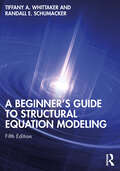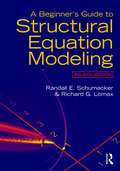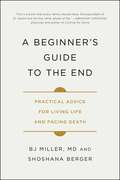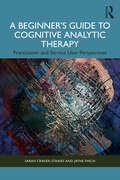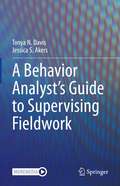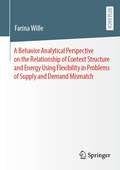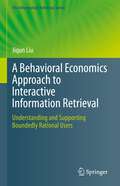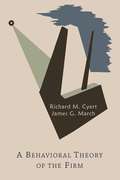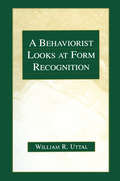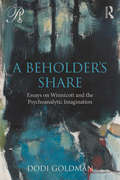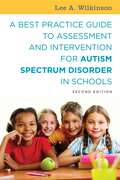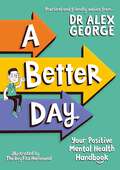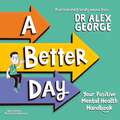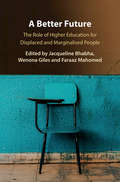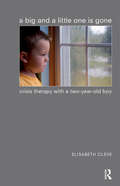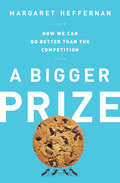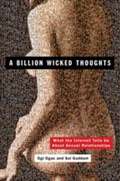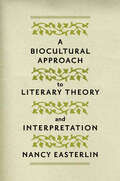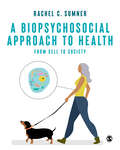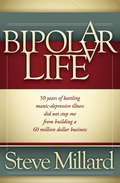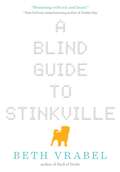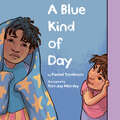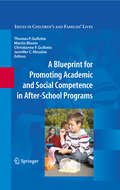- Table View
- List View
A Beginner's Guide to Structural Equation Modeling
by Tiffany A. Whittaker Randall E. SchumackerA Beginner’s Guide to Structural Equation Modeling, fifth edition, has been redesigned with consideration of a true beginner in structural equation modeling (SEM) in mind. The book covers introductory through intermediate topics in SEM in more detail than in any previous edition. All of the chapters that introduce models in SEM have been expanded to include easy-to-follow, step-by-step guidelines that readers can use when conducting their own SEM analyses. These chapters also include examples of tables to include in results sections that readers may use as templates when writing up the findings from their SEM analyses. The models that are illustrated in the text will allow SEM beginners to conduct, interpret, and write up analyses for observed variable path models to full structural models, up to testing higher order models as well as multiple group modeling techniques. Updated information about methodological research in relevant areas will help students and researchers be more informed readers of SEM research. The checklist of SEM considerations when conducting and reporting SEM analyses is a collective set of requirements that will help improve the rigor of SEM analyses. This book is intended for true beginners in SEM and is designed for introductory graduate courses in SEM taught in psychology, education, business, and the social and healthcare sciences. This book also appeals to researchers and faculty in various disciplines. Prerequisites include correlation and regression methods.
A Beginner's Guide to Structural Equation Modeling: Fourth Edition
by Richard G. Lomax Randall E. SchumackerNoted for its crystal clear explanations, this book is considered the most comprehensive introductory text to structural equation modeling (SEM). Noted for its thorough review of basic concepts and a wide variety of models, this book better prepares readers to apply SEM to a variety of research questions. Programming details and the use of algebra are kept to a minimum to help readers easily grasp the concepts so they can conduct their own analysis and critique related research. Featuring a greater emphasis on statistical power and model validation than other texts, each chapter features key concepts, examples from various disciplines, tables and figures, a summary, and exercises. Highlights of the extensively revised 4th edition include: -Uses different SEM software (not just Lisrel) including Amos, EQS, LISREL, Mplus, and R to demonstrate applications. -Detailed introduction to the statistical methods related to SEM including correlation, regression, and factor analysis to maximize understanding (Chs. 1 - 6). -The 5 step approach to modeling data (specification, identification, estimation, testing, and modification) is now covered in more detail and prior to the modeling chapters to provide a more coherent view of how to create models and interpret results (ch. 7). -More discussion of hypothesis testing, power, sampling, effect sizes, and model fit, critical topics for beginning modelers (ch. 7). - Each model chapter now focuses on one technique to enhance understanding by providing more description, assumptions, and interpretation of results, and an exercise related to analysis and output (Chs. 8 -15). -The use of SPSS AMOS diagrams to describe the theoretical models. -The key features of each of the software packages (Ch. 1). -Guidelines for reporting SEM research (Ch. 16). -www.routledge.com/9781138811935 which provides access to data sets that can be used with any program, links to other SEM examples, related readings, and journal articles, and more. Reorganized, the new edition begins with a more detailed introduction to SEM including the various software packages available, followed by chapters on data entry and editing, and correlation which is critical to understanding how missing data, non-normality, measurement, and restriction of range in scores affects SEM analysis. Multiple regression, path, and factor models are then reviewed and exploratory and confirmatory factor analysis is introduced. These chapters demonstrate how observed variables share variance in defining a latent variables and introduce how measurement error can be removed from observed variables. Chapter 7 details the 5 SEM modeling steps including model specification, identification, estimation, testing, and modification along with a discussion of hypothesis testing and the related issues of power, and sample and effect sizes.Chapters 8 to 15 provide comprehensive introductions to different SEM models including Multiple Group, Second-Order CFA, Dynamic Factor, Multiple-Indicator Multiple-Cause, Mixed Variable and Mixture, Multi-Level, Latent Growth, and SEM Interaction Models. Each of the 5 SEM modeling steps is explained for each model along with an application. Chapter exercises provide practice with and enhance understanding of the analysis of each model. The book concludes with a review of SEM guidelines for reporting research. Designed for introductory graduate courses in structural equation modeling, factor analysis, advanced, multivariate, or applied statistics, quantitative techniques, or statistics II taught in psychology, education, business, and the social and healthcare sciences, this practical book also appeals to researchers in these disciplines. Prerequisites include an introduction to intermediate statistics that covers correlation and regression principles.
A Beginner's Guide to the End: Practical Advice for Living Life and Facing Death
by Dr. BJ Miller Shoshana Berger&“A gentle, knowledgeable guide to a fate we all share&” (The Washington Post): the first and only all-encompassing action plan for the end of life.&“There is nothing wrong with you for dying,&” hospice physician B.J. Miller and journalist and caregiver Shoshana Berger write in A Beginner&’s Guide to the End. &“Our ultimate purpose here isn&’t so much to help you die as it is to free up as much life as possible until you do.&” Theirs is a clear-eyed and big-hearted action plan for approaching the end of life, written to help readers feel more in control of an experience that so often seems anything but controllable. Their book offers everything from step-by-step instructions for how to do your paperwork and navigate the healthcare system to answers to questions you might be afraid to ask your doctor, like whether or not sex is still okay when you&’re sick. Get advice for how to break the news to your employer, whether to share old secrets with your family, how to face friends who might not be as empathetic as you&’d hoped, and how to talk to your children about your will. (Don&’t worry: if anyone gets snippy, it&’ll likely be their spouses, not them.) There are also lessons for survivors, like how to shut down a loved one&’s social media accounts, clean out the house, and write a great eulogy. An honest, surprising, and detail-oriented guide to the most universal of all experiences, A Beginner&’s Guide to the End is &“a book that every family should have, the equivalent of Dr. Spock but for this other phase of life&” (New York Times bestselling author Dr. Abraham Verghese).
A Beginner’s Guide to Cognitive Analytic Therapy: Practitioner and Service User Perspectives
by Sarah Craven-Staines Jayne FinchThis text provides an accessible, reader-friendly guide to conducting Cognitive Analytic Therapy (CAT) on a one-to-one basis, developed in partnership with service users who have lived experience of CAT.The book will cover the applications of CAT in clinical practice including: assessment; introducing CAT; the main concepts and how to build a therapeutic relationship; mapping; the middle phase and the integration of other models; monitoring; developing exits; the ending and saying goodbye. Grounded in CAT theory, the content will be ordered sequentially, as one would conduct the therapy, and will feature first-hand accounts from CAT-experienced service users including their own perspectives on the model and the impact it had on their wellbeing.A straightforward, beginner’s introduction to practicing CAT, this book will be useful for trainee practitioners, assistant and trainee clinical/counselling psychologists, and those practising CAT-informed therapy in supervision.
A Behavior Analyst’s Guide to Supervising Fieldwork
by Tonya N. Davis Jessica S. AkersThis guide is specifically designed for supervisors of trainees completing fieldwork requirements for the Board-Certified Behavior Analyst (BCBA) credential, to ensure a well-planned and well-documented fieldwork experience. Supervisors have a significant responsibility to plan, sequence, implement, and track their supervisee's fieldwork and skill acquisition. This guide was created to align with the Board-Certified Behavior Analyst Task List, providing a structured curriculum to support the many responsibilities of a supervisor, and covering a wide range of topics. The book includes instructions for group and individual supervision activities, homework activities for supervisees, and methods of assessing skills. It is designed to support the supervisor by covering all aspects key to supervision. Its many additional materials are designed to maximize the supervisor's use of time, and to gauge the effectiveness of their work. It is evidence-based and practically oriented, and will benefit the supervisor as well as the trainee.
A Behavior Analytical Perspective on the Relationship of Context Structure and Energy Using Flexibility in Problems of Supply and Demand Mismatch
by Farina WilleEnabling an integration of large amounts of variable renewable energy (VRE) into an energy system is an important contribution to reduce part of its associated carbon dioxide emissions. A resulting challenge from integrating VRE is an increase in mismatch between supply and demand which could be reduced by increasing demand side flexibility in the residential sector by shifting energy using behavior. This thesis offers a theoretical and empirical analysis of energy using flexibility based on behavior analysis principles to relate what it can mean to account for a human dimension in an electrical energy system. To characterize degrees of freedom in allocating behavior and options for flexibility of energy using behavior, variability of behavioral patterns in terms of homogeneity between individuals is analyzed. Notably, even in times for which one could principally expect more variability between behavioral patterns such as in the afternoon and evening, one finds that behavioral activities are pre-structured, clearly limiting the possibilities for shifting energy using behavior. The behavior analytical perspective highlights the importance of addressing context structure and associated behavioral effort for shifting behavior, when addressing the challenge of mitigating the mismatch problem for a more sustainable energy system.
A Behavioral Economics Approach to Interactive Information Retrieval: Understanding and Supporting Boundedly Rational Users (The Information Retrieval Series #48)
by Jiqun LiuThis book brings together the insights from three different areas, Information Seeking and Retrieval, Cognitive Psychology, and Behavioral Economics, and shows how this new interdisciplinary approach can advance our knowledge about users interacting with diverse search systems, especially their seemingly irrational decisions and anomalies that could not be predicted by most normative models.The first part “Foundation” of this book introduces the general notions and fundamentals of this new approach, as well as the main concepts, terminology and theories. The second part “Beyond Rational Agents” describes the systematic biases and cognitive limits confirmed by behavioral experiments of varying types and explains in detail how they contradict the assumptions and predictions of formal models in information retrieval (IR). The third part “Toward A Behavioral Economics Approach” first synthesizes the findings from existing preliminary research on bounded rationality and behavioral economics modeling in information seeking, retrieval, and recommender system communities. Then, it discusses the implications, open questions and methodological challenges of applying the behavioral economics framework to different sub-areas of IR research and practices, such as modeling users and search sessions, developing unbiased learning to rank and adaptive recommendations algorithms, implementing bias-aware intelligent task support, as well as extending the conceptualization and evaluation on IR fairness, accountability, transparency and ethics (FATE) with the knowledge regarding both human biases and algorithmic biases.This book introduces a behavioral economics framework to IR scientists seeking a new perspective on both fundamental and new emerging problems of IR as well as the development and evaluation of bias-aware intelligent information systems. It is especially intended for researchers working on IR and human-information interaction who want to learn about the potential offered by behavioral economics in their own research areas.
A Behavioral Theory Of The Firm
by James March Richard Cyert2013 Reprint of 1963 First Edition. Full facsimile of the original edition, not reproduced with Optical Recognition Software. "A Behavioral Theory of the Firm" has become a classic work in organizational theory, and is one of the most significant contributions to theory intended to improve the operation of the modern corporation. The authors use experiments and empirical observations to build their model of decision making. They reject the structure of the firm as represented by classical economic theory, instead they focus on the discretion of management. They also offer a new way of viewing the effects of organization, communications and individuals on the firm's overall activity. This is path breaking book and among the most important and provocative interpretations yet advanced for seeing inside the firm to understand it as an organization and an economic entity.
A Behaviorist Looks at Form Recognition
by William R. UttalFor many years behaviorism was criticized because it rejected the study of perception. This rejection was based on the extreme view that percepts were internal subjective experiences and thus not subject to examination. This book argues that this logic is incorrect and shows how visual perception, particularized in the study of form recognition, can be carried out from the behavioral point of view if certain constraints and limitations are understood and accepted. The book discusses the idea of representation of forms, considers the major historical neural, psychological, and computational theories of form recognition, and then concludes by presenting a modern approach to the problem. In this book, William Uttal continues his critical analysis of the foundations of modern psychology. He is particularly concerned with the logical and conceptual foundations of visual perception and uses form recognition as a vehicle to rationalize the discrepancies between classic behaviorism and what we now appreciate are legitimate research areas.
A Beholder's Share: Essays on Winnicott and the Psychoanalytic Imagination
by Dodi GoldmanA Beholder's Share demonstrates how a sense of reality is evoked in the unpredictable space between imagination and adaptation. The world calls forth something in each of us—a beholder’s share—which in turn calls forth something in the world. Though usually viewed as opposites, imagination and reality make uneasy but necessary bedfellows.? Part I of A Beholder’s Share shows how fantasy generates novelty by creating versions of what is already known, while imagination allows what seems familiar to be seen afresh. Goldman’s essays offer unexpected takes on common clinical encounters: clashes of belief, the search for generational dialogue, the awkward discomfort of feeling like a fake, the problem of how and when to end analysis, the strains of working with psychotic anxieties. Part II, ‘Winnicott’s Living Legacy,’ illuminates Winnicott’s preoccupation with difficulties inherent in contact with reality. These chapters bring to life Winnicott’s personal struggle with an area of experience his own two analyses failed to touch, the tangled relationship with Masud Khan, his recognition of dissociation as "a queer kind of truth," and how Romantic poets shaped Winnicott’s view of what is felt as real.? Bringing together Dodi Goldman’s seminal and new writings, A Beholder’s Share will appeal to psychoanalysts and psychoanalytic psychotherapists, as well as students and teachers of the arts, literature, and humanities.
A Best Practice Guide to Assessment and Intervention for Autism Spectrum Disorder in Schools, Second Edition
by Lee WilkinsonFully updated to reflect DSM-5 and current assessment tools, procedures and research, this award-winning book provides a practical and scientifically-based approach to identifying, assessing, and treating children and adolescents with an Autism Spectrum Disorder (ASD) in school settings. Integrating current research evidence with theory and best-practice, the book will support school-based professionals in a number of key areas including: · screening and assessing children and youth with high-functioning autism spectrum conditions · identifying evidence-based interventions and practices · developing and implementing comprehensive educational programs · providing family support and accessing community resources · promoting special needs advocacy. Illustrative case examples, a glossary of terms and helpful checklists and forms make this the definitive resource for identifying and implementing interventions for pupils with ASD.
A Better Day: Your Positive Mental Health Handbook
by Dr. Alex GeorgeDr Alex George's debut book for children and young people.What if we could think of mental health in a positive way? Sweep away the rain clouds. Talk about what's on our minds. And care for our mental health in the same way we look after our bodies.In this empowering and hopeful handbook, Youth Mental Health Ambassador Dr Alex George is here to show us how.A Better Day is a positive, accessible and practical toolkit guiding young readers in how they can care for their mental health with confidence. From peer pressure and exam stress to online trolls and anxiety, life can be mentally draining. But though life is full of ups and downs, there are ways you can stay on top of your mental health - including overcoming stigma, talking about your feelings, developing resilience and switching your mindset.This book provides all the scaffolding and practical techniques to help you do this, so though you might be having a hard time right now, you can look toward your future with optimism and positivity. Because no matter what, there is always hope for a better day.
A Better Day: Your Positive Mental Health Handbook
by Dr. Alex GeorgeDr Alex George's debut audiobook for children and young people.What if we could think of mental health in a positive way? Sweep away the rain clouds. Talk about what's on our minds. And care for our mental health in the same way we look after our bodies.In this empowering and hopeful audio handbook, Youth Mental Health Ambassador Dr Alex George is here to show us how.A Better Day is a positive, accessible, and practical toolkit guiding young listeners in how they can care for their mental health with confidence. From peer pressure and exam stress to online trolls and anxiety, life can be mentally draining. But though life is full of ups and downs, there are ways you can stay on top of your mental health - including overcoming stigma, talking about your feelings developing resilience and switching your mindset.This audiobook provides all the scaffolding and practical techniques to help you do this, so though you might be having a hard time right now, you can look toward your future with optimism and positivity. Because no matter what, there is always hope for a better day.(P) 2022 Hodder & Stoughton Limited
A Better Future: The Role of Higher Education for Displaced and Marginalised People
by Wenona Giles Jacqueline Bhabha Faraaz MahomedPolicy makers, advocates and scholars have long concentrated on the importance of equal access to primary and secondary education as a foundation for a democratic and just society. Despite the growing importance of higher and specialist education in an increasingly technological and skill-focused global market, tertiary education has attracted much less attention. And yet, universities and colleges are epicentres of egregious disparities in access, which impinge on traditionally marginalized communities, such as racial minorities, migrants, indigenous populations, and people with disabilities. By drawing attention to this issue and assembling first-rate material from scholars and policy makers across the globe, this book performs an invaluable service for those interested in understanding and fighting a highly significant violation of educational opportunity and social justice.
A Big and a Little One is Gone: Crisis Therapy with a Two-year-old Boy
by Elisabeth CleveThis is a story from inside the child psychologist's room. Victor, who is two and a half years old, has lost his mother and younger brother in a car accident. He is 'sunny and happy' and does not cry. He is a child in deep crisis and comes for a crisis therapy. In this book we will follow Victor for his fifteen treatment sessions. He shows through play and activities how he is followed and piloted through his grief by his therapist. The healing by play therapy is depicted in words and pictures out of the perspective of both patient and therapist. The crisis therapy will work as the first link into a new future. In spite of the tragic reasons for the meetings, A Big and a Little One is Gone is a documentary story which brings both hope and courage.
A Bigger Prize: How We Can Do Better than the Competition
by Margaret HeffernanGet into the best schools. Land your next big promotion. Dress for success. Run faster. Play tougher. Work harder. Keep score. And whatever you do?make sure you win. Competition runs through every aspect of our lives today. From the cubicle to the race track, in business and love, religion and science, what matters now is to be the biggest, fastest, meanest, toughest, richest. The upshot of all these contests? As Margaret Heffernan shows in this eye-opening book, competition regularly backfires, producing an explosion of cheating, corruption, inequality, and risk. The demolition derby of modern life has damaged our ability to work together. But it doesnOCOt have to be this way. CEOs, scientists, engineers, investors, and inventors around the world are pioneering better ways to create great products, build enduring businesses, and grow relationships. Their secret? Generosity. Trust. Time. Theater. From the cranberry bogs of Massachusetts to the classrooms of Singapore and Finland, from tiny start-ups to global engineering firms and beloved American organizations?like Ocean Spray, Eileen Fisher, Gore, and Boston Scientific?Heffernan discovers ways of living and working that foster creativity, spark innovation, reinforce our social fabric, and feel so much better than winning. "
A Billion Wicked Thoughts
by Sai Gaddam Ogi OgasThe Book on Sex Want to know what really turns your partner on? A Billion Wicked Thoughts offers the clearest picture ever of the differences between male and female sexuality and the teeming diversity of human desire. What makes men attracted to images and so predictable in their appetites? What makes the set up to a romantic evening so important for a woman? Why are women’s desires so hard to predict? Neuroscientists Ogi Ogas and Sai Gaddam reveal the mechanics of sexual relationships based on their extensive research into the mountains of new data on human behavior available in online entertainment and traffic around the world. Not since Alfred Kinsey in the 1950s has there been such a revolution in our knowledge of what is really going on in the bedroom. What Ogas and Gaddam learned, and now share, will deepen and enrich the way you, and your partner, think and talk about sex. .
A Billion Wicked Thoughts: What the Internet Tells Us About Sexual Relationships
by Sai Gaddam Ogi OgasTwo maverick neuroscientists use the world's largest psychology experiment-the Internet-to study the private activities of millions of men and women around the world, unveiling a revolutionary and shocking new vision of human desire that overturns conventional thinking. For his groundbreaking sexual research, Alfred Kinsey and his team interviewed 18,000 people, relying on them to honestly report their most intimate experiences. Using the Internet, the neuroscientists Ogas and Gaddam quietly observed the raw sexual behaviors of half a billion people. By combining their observations with neuroscience and animal research, these two young neuroscientists finally answer the long-disputed question: what do people really like? Ogas and Gaddam's findings are transforming the way scientists and therapists think about sexual desire. In their startling book, Ogas and Gaddam analyze a "billion wicked thoughts" on the Internet: a billion Web searches, a million individual search histories, a million erotic stories, a half-million erotic videos, a million Web sites, millions of online personal ads, and many other enormous sources of sexual data in order to understand the true differences between male and female desires, including: ?Men and women have hardwired sexual cues analogous to our hardwired tastes-there are sexual versions of sweet, sour, salty, savory, and bitter. But men and women are wired with different sets of cues. ?The male sexual brain resembles a reckless hunter, while the female sexual brain resembles a cautious detective agency. ?Men form their sexual interests during adolescence and rarely change. Women's sexual interests are plastic and change frequently. ?The male sexual brain is an "or gate": A single stimulus can arouse it. The female sexual brain is an "and gate": It requires many simultaneous stimuli to arouse it. ?When it comes to sexual arousal, men prefer overweight women to underweight women, and a significant number of men seek out erotic images of women in their 40s, 50s, and 60s. ?Women enjoy writing and sharing erotic stories with other women. The fastest growing genre of erotic stories for women are stories about two heterosexual men having sex. ?Though the male sexual brain is much more different from the female sexual brain than is commonly believed, the sexual brain of gay men is virtually identical to that of straight men. Featuring cutting-edge, jaw-dropping science, this wildly entertaining and controversial book helps readers understand their partner's sexual desires with a depth of knowledge unavailable from any other source. Its fascinating and occasionally disturbing findings will rock our modern understanding of sexuality, just as Kinsey's reports did sixty years ago.
A Biocultural Approach to Literary Theory and Interpretation
by Nancy EasterlinCombining cognitive and evolutionary research with traditional humanist methods, Nancy Easterlin demonstrates how a biocultural perspective in theory and criticism opens up new possibilities for literary interpretation.Easterlin maintains that the practice of literary interpretation is still of central intellectual and social value. Taking an open yet judicious approach, she argues, however, that literary interpretation stands to gain dramatically from a fair-minded and creative application of cognitive and evolutionary research. This work does just that, expounding a biocultural method that charts a middle course between overly reductive approaches to literature and traditionalists who see the sciences as a threat to the humanities.Easterlin develops her biocultural method by comparing it to four major subfields within literary studies: new historicism, ecocriticism, cognitive approaches, and evolutionary approaches. After a thorough review of each subfield, she reconsiders them in light of relevant research in cognitive and evolutionary psychology and provides a textual analysis of literary works from the romantic era to the present, including William Wordsworth’s "Simon Lee" and the Lucy poems, Mary Robinson’s "Old Barnard," Samuel Taylor Coleridge’s "Dejection: An Ode," D. H. Lawrence’s The Fox, Jean Rhys’s Wide Sargasso Sea, and Raymond Carver’s "I Could See the Smallest Things."A Biocultural Approach to Literary Theory and Interpretation offers a fresh and reasoned approach to literary studies that at once preserves the central importance that interpretation plays in the humanities and embraces the exciting developments of the cognitive sciences.
A Biopsychosocial Approach to Health: From Cell to Society
by Rachel C. SumnerThis unique text takes a holistic approach to show you how different biological and medical aspects of health operate at the cellular level all the way up to the societal level, and back again. It explains key biological aspects of health at the cellular level (such as epigenetics and oxidative stress) to give you a solid understanding of how health is created in the context of the person, before working upwards to examine public health issues ranging from cardiovascular disease to unemployment and loneliness. Throughout the text, you will encounter a diverse range of cross-cultural examples, real-world scenarios and key questions which will help you put the theories and cell-to-society perspective you have learned into practice. With interdisciplinary perspectives from psychoneuroimmunology and epidemiology, this book offers an integrated consideration of health and its biopsychosocial determinants. It is a must-read for students of health psychology, applied psychology, nursing, and public health. Rachel C. Sumner is a psychobiologist and chartered psychologist with the British Psychological Society Division of Health Psychology and a senior research fellow at Cardiff Metropolitan University.
A Biopsychosocial Approach to Health: From Cell to Society
by Rachel C. SumnerThis unique text takes a holistic approach to show you how different biological and medical aspects of health operate at the cellular level all the way up to the societal level, and back again. It explains key biological aspects of health at the cellular level (such as epigenetics and oxidative stress) to give you a solid understanding of how health is created in the context of the person, before working upwards to examine public health issues ranging from cardiovascular disease to unemployment and loneliness. Throughout the text, you will encounter a diverse range of cross-cultural examples, real-world scenarios and key questions which will help you put the theories and cell-to-society perspective you have learned into practice. With interdisciplinary perspectives from psychoneuroimmunology and epidemiology, this book offers an integrated consideration of health and its biopsychosocial determinants. It is a must-read for students of health psychology, applied psychology, nursing, and public health. Rachel C. Sumner is a psychobiologist and chartered psychologist with the British Psychological Society Division of Health Psychology and a senior research fellow at Cardiff Metropolitan University.
A Bipolar Life: 50 Years of Battling Manic-Depressive Illness Did Not Stop Me From Building a 60 Million Dollar Business
by Steve MillardThe former Brookstone marketing guru gives &“proof of the fact that even in the face of this illness, a person can lead a rewarding and fulfilling life&” (Howard Lester, former Williams-Sonoma CEO). For more than forty-five years, Steve Millard has struggled with bipolar disorder. At his lowest, he was on the absolute brink of suicide, looking down into the abyss. Through his own methods of dealing with this disease, arrived at by trial and error, and the generous help of friends, and the teachings of a wonderful support group called Recovery Inc., he not only survived, he prospered, founding one of the most successful and profitable businesses in the direct marketing industry. A Bipolar Life is the story of his struggle. &“I have witnessed many of [Steve&’s] struggles with bipolar disorder and can only imagine how difficult they are for him. I have also witnessed his high, his incredible zest for life and the ability to live life to its fullest. But equally important, I have witnessed his marketing skills and how he helped pioneer the catalog and direct marketing industry. Those skills were a major part of the dynamic growth of the Brookstone Company.&” —Doug Anderson, former President, Brookstone &“Steve Millard was a good friend of L.L. Bean and a catalog marketing consultant instrumental to our success. He was upbeat and outgoing in his public life but quietly and courageously dealt with his emotional illness.&” —Leon Gorman, former CEO L.L. Bean
A Blind Guide to Stinkville
by Beth VrabelBefore Stinkville, Alice didn’t think albinism-or the blindness that goes with it-was a big deal. Sure, she uses a magnifier to read books. And a cane keeps her from bruising her hips on tables. Putting on sunscreen and always wearing a hat are just part of life. But life has always been like this for Alice. Until Stinkville.For the first time in her life, Alice feels different-like she’s at a disadvantage. Back in her old neighborhood in Seattle, everyone knew Alice, and Alice knew her way around. In Stinkville, Alice finds herself floundering-she can’t even get to the library on her own. But when her parents start looking into schools for the blind, Alice takes a stand. She’s going to show them-and herself-that blindness is just a part of who she is, not all that she can be. To prove it, Alice enters the Stinkville Success Stories essay contest. No one, not even her new friend Kerica, believes she can scout out her new town’s stories and write the essay by herself. The funny thing is, as Alice confronts her own blindness, everyone else seems to see her for the first time.This is a stirring small-town story that explores many different issues-albinism, blindness, depression, dyslexia, growing old, and more-with a light touch and lots of heart. Beth Vrabel’s characters are complicated and messy, but they come together in a story about the strength of community and friendship. This paperback edition includes a Q&A with the author and a sneak peak at the upcoming The Blind Guide to Normal.Sky Pony Press, with our Good Books, Racehorse and Arcade imprints, is proud to publish a broad range of books for young readers-picture books for small children, chapter books, books for middle grade readers, and novels for young adults. Our list includes bestsellers for children who love to play Minecraft; stories told with LEGO bricks; books that teach lessons about tolerance, patience, and the environment, and much more. While not every title we publish becomes a New York Times bestseller or a national bestseller, we are committed to books on subjects that are sometimes overlooked and to authors whose work might not otherwise find a home.
A Blue Kind of Day
by Rachel TomlinsonA moving picture book debut about depression, sensory awareness, and the power of listening, from psychologist and author of Teaching Kids to be Kind.Coen is having a sniffling, sighing, sobbing kind of day. His family thinks they know how to cheer him up. His dad wants to go outside and play, Mom tells her funniest joke, and his little sister shares her favorite teddy. Nothing helps. But one by one, they get quiet and begin to listen. After some time, space, and reassurance, Coen is able to show them what he needs.With poignant text and stunning illustrations, A Blue Kind of Day explores how depression might feel in the body and shows us how to support the people we love with patience, care, and empathy.
A Blueprint for Promoting Academic and Social Competence in After-School Programs (Issues in Children's and Families' Lives #10)
by Thomas P. Gullotta Martin Bloom Jennifer C. Messina Christianne F. GullottaSchool activities alone are not always sufficient to ensure children's academic progress or socio-emotional development and well-being. And the time when many children typically have the least adult supervision - immediately after school - is also the time that they are at the highest risk to act as perpetrators or become victims of antisocial behavior. Throughout A Blueprint for Promoting Academic and Social Competence in After-School Programs, which focuses on children in grades 1 through 6, noted experts identify the best practices of effective programs and pinpoint methods for enhancing school-based skills and making them portable to home and neighborhood settings. This volume: (1) Analyzes the concepts central to effective after-school programs. (2) Offers developmental, cognitive, and social ecology perspectives on how children learn. (3) Features more than 100 exercises that develop young people's capabilities for academic, social, moral, and emotional learning - These exercises are ready to use or can be adapted to students' unique needs. (4) Emphasizes young people's development as students and as productive members of society during middle to late childhood and early adolescence. (5) Presents explicit theory and evidence that can be used to explain the value of after-school programs for budget proposals. This important book will find an appreciative, ready audience among the program directors who design after-school curricula, the educators who implement them, the mental health and social work professionals who help staff them, and the current crop of graduate students who will create the next generation of programs.
